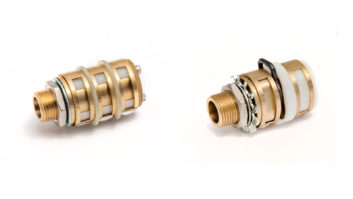
The SL20/20-2 offers a 4-step coarse gain pot and 12-step fine gain pot per channel.
The Sonic Lens SL20/20-2 mic preamp is the flagship product of Matthew Lesko’s company, UpState Audio. Lesko’s goal of creating an audiophile’s dream of a straight wire with gain took him on a 10-year journey and resulted in a 2-channel preamp housed in a sturdy, 18-pound single-rackspace unit with simple and solid controls.
The SL20/20-2’s meager documentation provides a roadmap of gain settings provided by the unit’s four-position gain and multiposition fine-tuning rotary knobs, both of which are detented for easy recall and adherence to a balanced signal path throughout. All of the unit’s parts — including the incredibly overbuilt power supply under the hood — speak to Lesko’s “quality first, cost be damned” philosophy. The lengths to which Lesko went to achieve his goal resulted in some incredible specs. The SL20/20-2 promises to deliver no greater than +0/-3dB deviation between 0.3 and 270k Hz. I put this claim and more to the test with an Audio Precision APx525 system; to see these tests, go to mixonline.com/online_extras/sonic_lens_sl20_bench_tests.
I Can Hear Clearly Now
The first job for the Sonic Lens was adding gain to a spaced pair of BLUE Omni Mouse microphones placed two feet over the cymbals on a drum kit. When soloed, this mic/preamp combination sounded excellent: The stereo picture was wide, while the transients from sticks on the cymbals and toms sounded like my head was above the kit. The true surprise came when I incorporated the overheads with the rest of the mics on the kit. The SL20/20-2 acted like glue by ably providing the majority of the stereo mix, which was bolstered by the other mics. I can’t say enough about the temporal (time-domain) accuracy that this preamp provided. Two-channel recordings are lush, wide and true to any off-axis information provided by the mics.
During different sessions, I listened as the Sonic Lens powered a variety of other pairs of mics above drum kits, including a Royer SF24V stereo tube ribbon mic, a spaced pair of SE Electronics SE-3s and BLUE Bottles. The Royer’s stereo image, transient response and ribbon-tube personality made it the perfect pairing with the Sonic Lens. The SE-3s and BLUE Bottles also sounded exemplary. Keep in mind that these mics vary in price by more than $4,000 each, which brings me to an important point: Over and over again, I found that the SL20/20-2 made good mics sound great and great mics sound spectacular. It was always a pleasant bonus to hear the surprising miking results over a range of situations.
I couldn’t wait to hear the SL20/20-2 in as many other situations as possible. An electric bass through a Radial Engineering passive DI sounded rich in overall tonal content and full at the bottom end. Male vocals through a Shure SM7 offered rock-solid results, with the Lens giving up plenty of clean and quiet gain. The Royer SF24V powered by the SL20/20-2 provided a great stereo recording of a blazing guitar amp; high SPL was not a problem with this mic/preamp combo.
Neumann TLM 103s placed over a drum kit had excellent sonic clarity and presented a natural-sounding picture of the kit. Even mics that are considered on the affordable side shined when paired with the SL20/20-2. The SE Electronics SE3s were excellent over another kit with plenty of great transients from the well-tuned toms and a very musical rendition of the cymbals.

Distortion was well below audibility in all of my listening tests, which the APx525 bench tests confirmed. Second-order harmonic distortion was below -90 dB with 3rd through 6th orders diminishing between -110 dB and -120 dB.
A Revelation
Hands-down, the Sonic Lens is the most true-to-life mic preamp I’ve ever heard or tested. You may disagree with the clean machine design philosophy, instead wanting a preamp that offers color, but you can’t argue with the SL20/20-2’s superb implementation and results. I had the chance to sample a variety of mics in stereo over different drum kits and quickly decided that before the SL20/20-2 I hadn’t been hearing my mics to their full potential. The unit’s sonic integrity and super-low noise floor will step up the game of any mic in your collection, especially in pairs.
If you’re looking for the preamp for your collection, this is the one. Yes, the price is dear, but not when you’re paying for an instant classic.
Kevin Becka is Mix’s technical editor.








